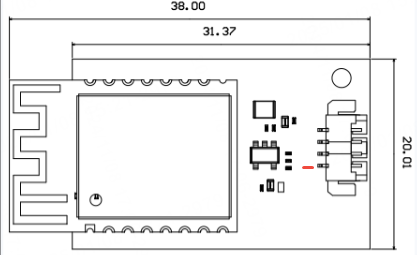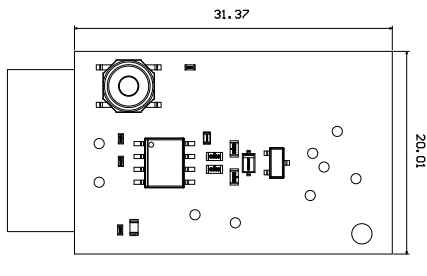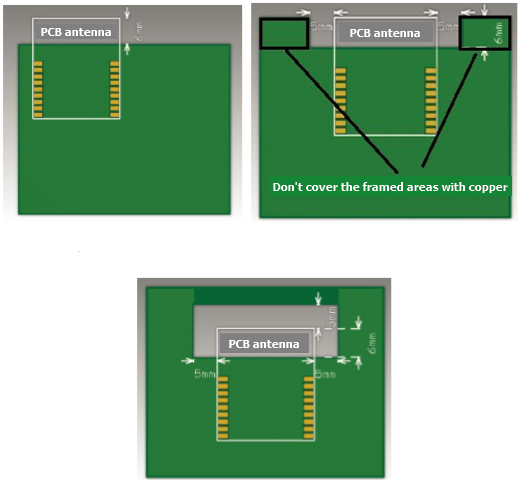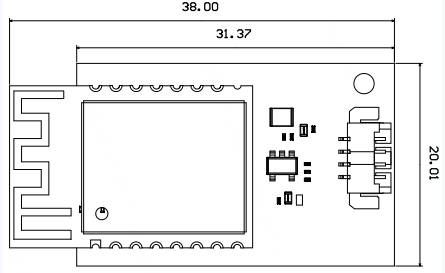HS01-485-WBR3 Module Datasheet
Last Updated on : 2025-05-29 06:21:54download
Overview
HS01-485-WBR3 is a module that uses an RS-485 interface for transparent transmission over Wi-Fi. It consists of a highly integrated wireless RF chip RTL8720CF, RS-485 chip, and DC-DC power supply chip, with built-in Wi-Fi stacks and various library functions. This module combines a low-power KM4 microcontroller unit (MCU), WLAN MAC, and 1T1R (1 transmitter/1 receiver) design. It provides output frequency up to 100 MHz, 256 KB embedded SRAM, 2 MB flash memory, and configurable GPIOs that can function as digital peripherals for diverse applications.
Features
-
Built-in low-power KM4 MCU that also acts as an application processor.
- Clock rate of 100 MHz.
-
Operating voltage: 5V.
-
Peripheral: 1 universal asynchronous receiver/transmitter (UART).
-
Wi-Fi connectivity
-
IEEE 802.11 b/g/n20.
-
Channels 1 to 14 at 2.4 GHz.
-
Support security protocols like WPA and WPA2.
-
The maximum output power is +20 dBm for IEEE 802.11b transmission.
-
Support access point (AP) mode.
-
Support Wi-Fi Easy Connect (EZ mode) pairing mode on Android and iOS devices.
-
Onboard PCB antenna.
-
Operating temperature range: -20°C to +85°C.
-
Applications
- Smart building
- Smart home and electrical appliance
- Healthcare
- Industrial wireless control
- Handheld device
Module interfaces
Dimensions and footprint
The electrical interface of the adapter board is a PH-4AW connector with a pin pitch of 2.54 mm.
The dimensions of the adapter board are 20 mm ± 0.35 mm (W) × 38 mm ± 0.35 mm (L) × 8.0 ± 0.15 mm (H). The figure below shows the dimensions and footprint design.
H is the total height from the components on the bottom side to those on the top side of the adapter board.


Pin definition
The following table lists the pin definitions.
| Pin | Symbol | I/O type | Description |
|---|---|---|---|
| 1 | 5V | P | 5V power input pin |
| 2 | A | I/O | RS-485 communication port A |
| 3 | B | I/O | RS-485 communication port B |
| 4 | GND | P | Ground pin |
P indicates the power pin, and I/O indicates the input and output pin.
Definitions of test points
The following table lists the test points.
| Pin | Symbol | I/O type | Description |
|---|---|---|---|
| 1 | 3V3 | P | 3.3V power pin on the module, used for flashing |
| 2 | GND | P | Ground pin |
| 5 | Rx | I/O | UART0_Rx used for authorization |
| 6 | Tx | I/O | UART0_Tx used for authorization |
| 7 | LOG_Tx | I/O | Serial port Tx for logging |
| 8 | LOG_Rx | I/O | Serial port Rx for logging |
P indicates the power pin, and I/O indicates the input and output pin.
Electrical parameters
Absolute electrical parameters
Absolute parameters:
| Parameter | Description | Min value | Max value | Unit |
|---|---|---|---|---|
| Ts | Storage temperature | -20 | 85 | °C |
| VCC | Supply voltage | 2.5 | 5.5 | V |
| Electrostatic discharge voltage (human body model) | TAMB -25°C | - | 2 | kV |
| Electrostatic discharge voltage (machine model) | TAMB -25°C | - | 0.5 | kV |
Operating conditions
Normal operating conditions:
| Parameter | Description | Min value | Typical value | Max value | Unit |
|---|---|---|---|---|---|
| Ta | Operating temperature | -20 | - | 85 | °C |
| VCC | Operating voltage | 4.5 | 5 | 5.5 | V |
| VIL | I/O low-level input | -0.3 | - | VCC × 0.25 | V |
| VIH | I/O high-level input | VCC × 0.75 | - | VCC | V |
| VOL | I/O low-level output | - | - | VCC × 0.1 | V |
| VOH | I/O high-level output | VCC × 0.8 | - | VCC | V |
| Imax | I/O drive current | - | - | 5 | mA |
Wi-Fi transmit power consumption
Power consumption during continuous transmission (TX)
| Symbol | Mode | Power | Typical value | Unit |
|---|---|---|---|---|
| IRF | 802.11b, 11 Mbit/s | 18 dBm | 231 | mA |
| IRF | 802.11g, 54 Mbit/s | 15 dBm | 159 | mA |
| IRF | 802.11n, MCS7 (20M) | 13 dBm | 145 | mA |
Wi-Fi receive power consumption
Power consumption during continuous reception (RX)
| Symbol | Mode | Average value | Peak (Typical) value | Unit |
|---|---|---|---|---|
| IRF | 802.11b, 11 Mbit/s | 63 | 65 | mA |
| IRF | 802.11g, 54 Mbit/s | 65 | 67 | mA |
| IRF | 802.11n HT20 MCS7 | 65 | 67 | mA |
RF features
Basic RF features
Basic RF features:
| Parameter | Description |
|---|---|
| Operating frequency | 2.400 to 2.4835 GHz |
| Wi-Fi standard | IEEE 802.11b/g/n (channels 1–14) |
| Data transmission rate |
|
| Antenna type | PCB antenna |
Wi-Fi output power
Power during continuous transmission (TX):
| Parameter | Min value | Typical value | Max value | Unit |
|---|---|---|---|---|
| RF average output power, 802.11b CCK mode, 1 Mbit/s | - | 17.5 | - | dBm |
| RF average output power, 802.11g OFDM mode, 54 Mbit/s | - | 14.5 | - | dBm |
| RF average output power, 802.11n/n20 OFDM mode, MCS7 | - | 13.5 | - | dBm |
| Frequency error | -20 | - | 20 | ppm |
Wi-Fi receiver (RX) sensitivity
RX sensitivity
| Parameter | Min value | Typical value | Max value | Unit |
|---|---|---|---|---|
| PER < 8%, RX sensitivity, 802.11b CCK mode, 1 Mbit/s | - | -96 | - | dBm |
| PER < 10%, RX sensitivity, 802.11g OFDM mode, 54 Mbit/s | - | -75 | - | dBm |
| PER < 10%, RX sensitivity, 802.11n/n20 OFDM mode, MCS7 | - | -72 | - | dBm |
Antenna information
Antenna type
There are two types of antennas: PCB antenna and external antenna. The PCB antenna is used by default. If you need to connect an external antenna, please contact Tuya sales personnel.
Antenna interference reduction
When a PCB antenna is used on a Wi-Fi module, we recommend that the module antenna is at least 15 mm away from other metal components. This can optimize the Wi-Fi performance. Traces and copper pour areas are not allowed in the antenna area of the PCB. Otherwise, antenna performance might be reduced.
Layout principles: Make sure that there is no substrate medium directly below or directly above the PCB antenna. Make sure that the printed antenna is away from the copper sheet. This maximizes the radiation performance of the antenna.

Packing and manufacturing
Mechanical dimensions
The dimensions of the adapter board are 20 mm ± 0.35 mm (W) × 38 mm ± 0.35 mm (L) × 8.0 mm ± 0.15 mm (H).
H is the total height from the components on the bottom side to those on the top side of the adapter board.


Production instructions
A delivered module must meet the following storage requirements:
- The moisture-proof bag must be placed in an environment where the temperature is below 30°C and the relative humidity is lower than 85%.
- The shelf life of a dry-packaged product is 6 months from the date when the product is packaged and sealed.
- During the whole production process, operators at each station must wear electrostatic rings.
- During operation, keep the module away from water or dirt.
Is this page helpful?
YesFeedbackIs this page helpful?
YesFeedback





